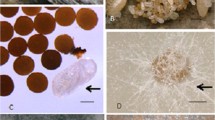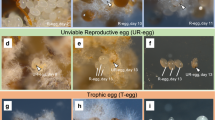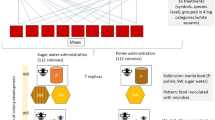Summary
Incipient colonies of the fungus-growing termiteMicrotermes sp. nr.usambaricus (Macrotermitinæ) have been successfully cultured in the laboratory up to the stage where a viable fungus comb was established. The primordial fungus comb is inoculated with fungusTermitomyces by the female reproductive which ingests asexual spores (conidia) from the comb before leaving the parental nest. These conidia survive in the digestive tube until, 10–11 weeks after colony foundation, the first new fungus comb is built.
The comb is built entirely of fæcal material and appears from these preliminary observations to require 5 weeks digestive action by the fungus before it is re-consumed by theMicrotermes workers.
Within the Macrotermitinæ the ability of incipient colonies to produce a viable fungus comb has been demonstrated only in the genusMicrotermes and a single species of the genusMacrotermes. In both cases the reproductives transport the fungal spores in their digestive tube. This highly evolved adaptation to the fungal symbiosis has clearly played an important part in establishing the wide distribution and abundance of the genusMicrotermes.
Resume
De nouvelles colonies du termites champignonisteMicrotermes sp. cf.usambaricus (Macrotermitinæ) ont été élevées avec succès en laboratoire jusqu'au stade de l'établissement d'une meule à champignons viable. La première meule est «ensemencée» avec leTermitomyces par la femelle reproductrice, qui a ingéré des spores asexuées (conidies) de la meule avant de quitter le nid parental. Ces conidies survivent dans le tube digestif jusqu'au moment où la première meule à champignons est construite, 10–11 semaines après la fondation de la colonie.
La meule est entièrement faite de matières fécales et les observations préliminaires semblent indiquer que 5 semaines de digestion par le champignon sont nécessaires avant que la meule soit consommée par lesMicrotermes ouvriers.
Chez les Macrotermitinæ, l'aptitude des colonies nouvellement fondées à produire une meule à champignons viable n'a été mise en évidence que chez le genreMicrotermes et chez une seule espèce du genreMacrotermes. Dans les deux cas, les reproducteurs transportent les spores du champignon dans leur tube digestif. Cette adaptation très évoluée à la symbiose fongique a de toute évidence joué un rôle important dans la large répartition et l'abondance du genreMicrotermes.
Similar content being viewed by others
References
Bigger M., 1966. — The biology and control of termites damaging field crops in Tanganyika.Bull. ent. Res., 56, 417–444.
Chatterjee P.N., Thakur M.L., 1964. — Revision of the termite genusMicrotermes Wasmann for the Indian Region.Indian Forest Rec., 10, 219–260.
Grassé P.P., Noirot C., 1951. — NOuvelles recherches sur la biologie de divers Termites champignonistes (Macrotermitinæ).Ann. Sci. nat. (Zool.),11, 291–342.
Grassé P.P., Noirot C., 1955. — La fondation de nouvelles sociétés parBellicositermes natalensis (Hav.).Insectes soc., 2, 213–220.
Harris W.V., 1969. — Termites as pests of crops and trees.Commonwealth Institute of Entomology, London.
Kemp P.B., 1955. — The termites of north-eastern Tanganyika, their distribution and biology.Bull. ent. Res., 46, 113–135.
Lüscher M., 1949. — Continuous observation of termites in laboratory cultures.Acta trop., 6, 161–165.
Lüscher M., 1951. — Beobachtungen uber die Kolonie-grundung bei verschiedenen africanischen Termitenarten.Acta trop., 8, 36–43.
Noirot C., 1955. — Recherches sur le polymorphisme des Termites supérieurs (Termitidæ).Ann. Sci. Nat. Zool. Biol. Animale, 17, 399–595.
Sands W.A., 1960. — The initiation of fungus comb construction in laboratory colonies ofAncistrotermes guineensis (Silvestri).Insectes soc., 7, 251–259.
Sands W.A., 1969. — The association of termites and fungi.In Biology of Termites (K. Krishna and F.M. Weesner, eds) vol. 1, pp. 495–524.Academic Press, New York and London.
Williams R.M.C., 1959. — Flight and colony foundation in twoCubitermes species (Isoptera: Termitidæ).Insectes soc., 6, 203–218.
Wood T.G., Johnson R.A., Ohiagu C.E., 1977. — Populations of termites (Isoptera) in natural and agricultural ecosystems in Southern Guinea Savanna near Mokwa, Nigeria.Geo-Eco-Trop, 1, 139–148.
Author information
Authors and Affiliations
Rights and permissions
About this article
Cite this article
Johnson, R.A. Colony development and establishment of the fungus comb inMicrotermes sp. nr.Usambaricus (Sjöstedt) (Isoptera: Macrotermitinae) from Nigeria. Ins. Soc 28, 3–12 (1981). https://doi.org/10.1007/BF02223617
Received:
Accepted:
Issue Date:
DOI: https://doi.org/10.1007/BF02223617




